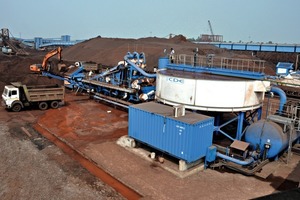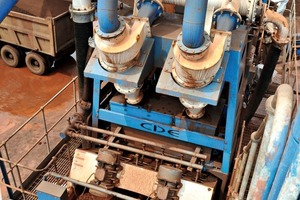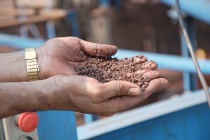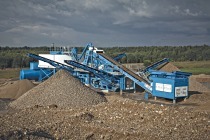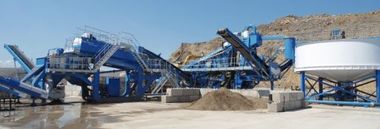New mobile iron ore washing plant in India
A new mobile iron ore washing plant for Bhushan Power & Steel is delivering a substantial increase in Fe through the effective removal of alumina and silica from the feed material. Introduction of the M2500 (Fig. 1) washing plant from CDE Asia to the Bhushan Power & Steel facility in Orissa/India has resulted in an increase in Fe from 58.24 % to 63.2 % which delivers significant efficiency savings in downstream processes. The increase in Fe has been achieved as a result of a 37 % reduction in alumina from 4.3 % to 2.7 % and a 32 % reduction in silica from 6.6 % to 4.5 %. Commenting on these results Dr. Arabinda Bandyopadhay of CDE Asia said: “The increase in Fe will lead to a reduction in coal consumption of around 5 % during the various steel production processes which represents a very significant efficiency gain for Bhushan Power & Steel.” This project represents the completion of a major product development initiative by CDE to produce a mobile washing plant suitable for application in the iron ore processing sector.
“The success of the M2500 on this iron ore washing project is evidence that the major product developments we have introduced over the last 12 months will lead to further opportunities in iron ore applications not only in India but throughout the world” says Dermot Murphy, Strategic Projects Manager at CDE Global. The M2500 has now been applied on a wide variety of projects in Europe, Asia, Australasia and Latin America on materials including sand & gravel, crushed rock, scalpings, construction & demolition waste recycling and iron ore washing.
The new iron ore washing plant is located in Sambalpur in the state of Orissa and in addition to the M2500 mobile washing plant there is an AquaCycle A600 thickener allowing for recycling of 90 % of the water used as well as significantly reducing the space required for settling ponds. The processing capacity of the plant in this instance is 200 t/h of -40 mm material and the washed products are -5 mm washed fines in addition to 5–16 mm and +16 mm washed ore. The washed ore is subsequently used as input to the blast furnace.
It is the compact, modular nature of the M2500 (Fig. 2) that made it appealing to Bhushan Power & Steel as it integrates a feed system, screening, fines washing and stockpiling onto a single chassis. The -40 mm material is first delivered to the integrated feed hopper before being sent to the ProGrade screening phase by a 14 m feed conveyor. A washbox is located at the head of the feed conveyor to add sufficient water to the material to ensure efficient screening. Following this the material is discharged to the double deck rinsing screen and the washed +16 mm ore and 5–16 mm ore are subsequently stockpiled via the 2 integrated 9 m wing conveyors offering a stockpile capacity of 150 m3.
The -5 mm material is sent from the screen sump to the integrated fines washing plant and is initially delivered to the customised hydrocyclone set up. The cluster of hydrocyclones specified on this project have been lined with XTril high wear resistance liners designed to cope with the harsh operating conditions of iron ore processing. The washed
-5 mm fines are then stockpiled via another integrated 9 m stockpile conveyor to 12 % moisture content which ensures that it can be introduced to downstream processes very soon after it has been washed.
Following processing of the -5 mm iron ore fines through the dual pass washing system the waste water containing the -75 micron (200 mesh) material is the delivered to the adjacent AquaCycle thickener to allow for recycling of wash water to the M2500. This serves a dual purpose in that it reduces the volume of fresh water required to feed the washing plant while also reducing the space required to accommodate on site settling ponds.
Once the waste material is delivered to the AquaCycle thickener it is dosed with flocculant in the deaeration chamber. This flocculant has been prepared in the FlocStation polyelectrolyte dosing plant which is housed in an insulated 6 m cabin located beside the AquaCycle. This flocculant assists the sludge settlement process by forcing the fine particles to bind together and sink to the bottom of the tank where the CDE QuadRake mechanism ensures the sludge density is optimised for discharge via the integrated slurry pump. Meanwhile the recycled water overflows a weir at the top of the AquaCycle thickener and is re-circulated around the washing plant.

